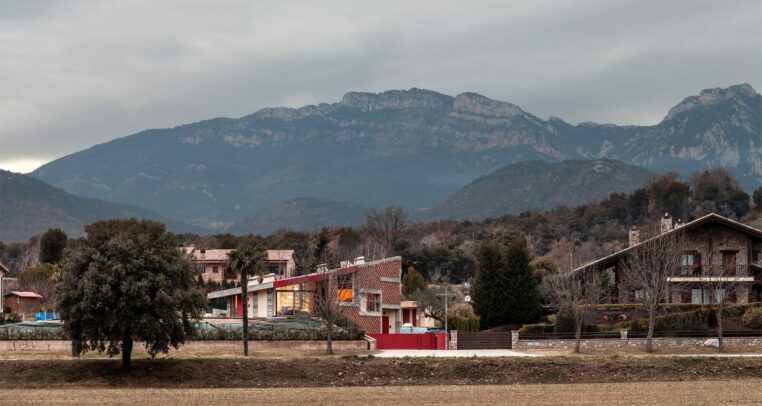







Walk through the fields in Graugés, a landscape of gentle hills in the area between the Catalan Central Depression and the Pre-Pyrenees, the walker finds two lakes and discovers a trace. A broken line arises and crosses the site diagonally, a lattice wall built in concrete and brick. Xavi and Queralt, the owners, assume the trace and the deed defines the plot.
Walk with them for years, tracing the trail, that wall. Embracing it. Hall, kitchen, bedrooms, auxiliary bodies, pool and garden embrace the wall and shape the house. Build up the soil to shape future family topographies with children skating down the access ramp. This is the first element of the spiral that configures the house and recognizes the natural orography of the site. One, the ramp. Two, the kitchen, dining room and living room where the ramp lands. Three, change of direction, five steps and a second living room. Four, five more steps and the main bedroom. Six, last five steps and two more bedrooms above the entrance hall and the kitchen. Seven, facing the double-height living space and waiting for a fireman’s pole, which will never arrive.
An attempt to capture the sunset light below a single slope roof, conveniently bent not to offend the local authorities eager of “traditional ceramic tiles roofing”. With this bending movement the house bows to the walker in the street, and accumulates its larger volume to the back, the garden and more private area.
Look from up to down, touching the concrete roof with the hand and, in some places, with the head; the height expands and contracts to define the public spaces and embrace other more private. Adjust the scale to different situations that coexist in the house.
Build the house as hierarchical process, which was also useful to think it, adding elements and processes. A precise and crucial concrete structure, necessary to support the outer skin and win the war in the first battle. Add the rest and cover the whole: a lattice brick wall, rendered walls and carpentry work to one side and window shutters at the other.
The interior expresses the concrete in vertical screens and ceiling, opposed to the vertical rendered stripes. The different rooms are finally set up through the construction of free-standing bodies, almost as obstacles on the upstroke. Cheerful glazed ceramic bodies clothed in bright colours spread the space and house servicing.
The piece used in the lattice is a conventional handcrafted brick. In this case, the reflection is based on the non-conventional placement of the same, when grouped in nodes of three units generating a solid and a void of square matrix.
The interior pieces are made of glazed stoneware in different colours, both on the floor and on the wall. The ceramic pieces were manufactured by Ceràmica Cumella. The transition between both is made by a quarter-curve section piece, providing continuity to both planes. The side pieces are also glazed at the head, giving the image of a continuous solid.
Private
Structure: Eduardo Reus
Technical Architect: Jordi Culell
Facilities: ORDEIC
Estructures Muvi S.A
Llac Street, 6, 08610 Avià, Spain